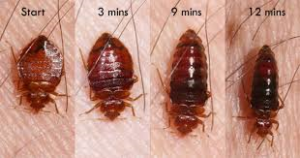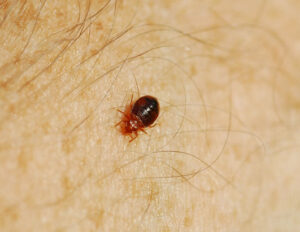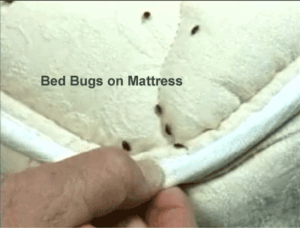We Specialize in Bed Bug Eradication…Not Just… Bed Bug Control |
 |
| Security Pest is an Industry Leader in Bed Bug Treatments We’ve successfully treated over 3,700 bed bug infestations. |
Important Bed Bug Treatment Info:
To completely eliminate a bed bug infestation from your Massachusetts dwelling it is necessary to treat more than just the room where people are getting bitten by bed bugs at night. Most of the bedbugs will be in the room close to the person getting bitten, but they can travel quite quickly across floors, walls and ceilings. They get spread around the home when we move items such as; clothing or any other item that might have been kept in an area with a bed bug infestation. Thus, bed bugs are also commonly found in the laundry room and the living room. If bed bugs in the living room find someone sleeping on the couch, that room also will quickly become infested. Thus, the best way to totally eliminate a bed bug infestation is to thoroughly treat the problem room along with all surrounding areas.
Call us at 1-800-362-2687 anytime between 8:00AM and 5:00PM for any questions or pricing information.
Security Bedbug Treatments:
Successful bed bug extermination requires an experienced bed bug exterminator. Only a skilled and experienced pest control technician can find and completely eliminate a bed bug infestation from your home or apartment. Our bed bug exterminators average over 15 years experience in performing bed bug treatments. Bed bug treatments need two scheduled treatments for us to eliminate this major pest. We perform many bed bug pest control treatments every month. Bed bug aren’t just found in urban areas. People who travel a lot have a greater chance of picking up bed bugs in their suitcases from motel and hotel rooms and bringing them back to their homes.
Bed Bugs Treatment – Security Bed Bug Control performs 2 scheduled bed bug treatments spaced about 2 weeks apart to ensure complete bed bug extermination. We then give the customer an extended warranty against any bedbug re-infestation.
Post – Bedbug Treatment Procedures:
After our professional bedbug treatment, allow all treated surfaces to completely dry before use. We recommend staying out of the unit for around 4 plus hours. Check beds for complete dryness before replacing sheets. Note: Bedding or linens should be dry cleaned or laundered in hot water and dried using the “hot” setting. Also, after a bed bug treatment it is highly recommended that you purchase a zippered mattress and box spring protector. These will tightly enclose and protect the mattress and the box spring from being reinfested with bed bugs

Bed Bug Bites:
Getting night bug bites in bed is usually the first sign of a bed bug infestation. The bite is painless. The salivary fluid injected by bed bugs typically causes the skin to become irritated and inflamed, although individuals can differ in their sensitivity. A small, hard, swollen, white welt may develop at the site of each bite. Many people develop a red bump around the bite area. This is accompanied by severe itching that lasts for several hours to days. Scratching may cause the welts to become infected. The amount of blood loss due to bed bug feeding typically does not adversely affect the host.
Rows of three or so welts on exposed skin are characteristic signs of bed bugs. Welts do not have a red spot in the center such, as is characteristic of fleabites. Bedbugs bite the host most commonly around the waist while in bed sleeping. However, bites may occur on exposed skin such as arms and legs. Some individuals respond to bed bug infestations with anxiety, stress, and insomnia. Bed bugs are not known to transmit disease, but its affect on people is substantial and debilitating.
Bedbugs Are Back:
In the past decade, bed bugs have begun making a comeback across the United States. Massachusetts has been particularly hard hit because of all the traveling our citizens do. The widespread use of baits rather than insecticide sprays for ant and cockroach control is a factor that has been implicated in their return. Bed bugs are blood feeders that do not feed on ant and cockroach baits. International travel and commerce are thought to facilitate the spread of these insect hitchhikers, because eggs, young, and adult bed bugs are readily transported in luggage, clothing, bedding, and furniture. Bed bugs can infest airplanes, ships, trains, and buses. Bed bugs are most frequently found in Massachusetts dwellings with a high rate of occupant turnover, such as hotels, motels, hostels, dormitories, shelters, nursing homes, apartment complexes, tenements, and prisons. Such infestations usually are not a reflection of poor hygiene or bad housekeeping.
Bedbug Identification:
Adult bed bugs are brown to reddish-brown, oval-shaped, flattened, and about 3/16 to 1/5 inch long. Their flat shape enables them to readily hide in cracks and crevices. The body becomes more elongate, swollen, and dark red after a blood meal. Bed bugs have a beak-like piercing-sucking mouth part system. The adults have small, stubby, nonfunctional wing pads. Newly hatched nymphs are nearly colorless, becoming brownish as they mature. Nymphs have the general appearance of adults. Eggs are white and about 1/32 inch long.
Note: Bed bugs superficially resemble a number of closely related insects, such as bat bugs (Cimex adjunctus). A microscope is needed to examine the insect for distinguishing characteristics, which often requires the skills of an entomologist. In some states, such as Ohio, bat bugs are far more common than bed bugs. Bat bugs prefer bats, but if the host animals are removed and the bat bugs are left untreated, they will seek out a human host. If you live in or visit a building with a bat infestation or recently corrected bat problem, this could be a possible source of bites.
Bedbug Life Cycle:
Female bed bugs lay from one to twelve eggs per day, and the eggs are deposited on rough surfaces or in crack and crevices. The eggs are coated with a sticky substance so they adhere to the substrate. Eggs hatch in 6 to 17 days, and nymphs can immediately begin to feed. They require a blood meal in order to molt. Bed bugs reach maturity after five molts. Developmental time (egg to adult) is affected by temperature and takes about 21 days at 86° F to 120 days at 65° F. Bed bugs can go without feeding for 80 to 140 days; older stages can survive longer without feeding than younger ones. Adults have survived without food for as long as 550 days. A bed bug can take six times its weight in blood and feeding can take 3 to 10 minutes. Adults live about 10-14 months and there can be 3 to 4 generations of bed bugs per year.
Bedbug Habits:
Bed bugs are fast moving insects that are nocturnal blood-feeders. They feed mostly at night when their host is asleep. After using their sharp beak to pierce the skin of a host, they inject a salivary fluid containing an anticoagulant that helps them obtain blood. Nymphs may become engorged with blood within three minutes, whereas a full-grown bed bug usually feeds for ten to fifteen minutes. They become elongated after a blood meal. They then crawl away to a hiding place to digest the meal. The sole source of food is the blood meal they take at night from humans or bats during the day. When hungry, bed bugs again search for a host. Bed bugs hide during the day in dark, protected sites. They seem to prefer fabric, wood, and paper surfaces. They usually occur in fairly close proximity to the host, although they can travel far distances. Bed bugs initially can be found about tufts, seams, and folds of mattresses, later spreading to crevices in the bedstead. In heavier infestations, they also may occupy hiding places farther from the bed. They may hide in window or doorframes, electrical boxes, floor cracks, baseboards, furniture, and under the tack board of wall-to-wall carpeting. Bed bugs often crawl upward to hide in pictures, wall hangings, drapery pleats, loosened wallpaper, cracks in plaster, and ceiling moldings.
Bedbug Symptoms:
A bed bug infestation can be recognized by bloodstains from crushed bugs or by rusty (sometimes dark) spots of excrement on sheets and mattresses, bedclothes, and walls. Fecal spots, eggshells, and shed skins may be found in the vicinity of the bed bugs hiding places. An offensive, sweet, musty odor from their scent glands may be detected when bed bug infestations are severe in our Massachusetts homes and apartments.
Bed Bug Control Measures:
A critical first step is to correctly identify the blood-feeding pest, as this determines which management tactics to adopt that take into account specific bug biology and habits. For example, if the blood-feeder is a bat bug rather than a bed bug, a different management approach is needed. If you have bat bugs which look very similar to bed bugs, you will need to rid the bat colony from your Massachusetts home. Then, you will need a bat bug treatment performed to eliminate the bat bug infestation from your attic.
Control of bed bugs is best achieved by following an integrated pest management (IPM) approach that involves multiple tactics, such as preventive measures, sanitation, and chemicals applied to targeted sites. Once the bedbugs have spread, infestations are best handled by a licensed pest management professional highly experienced in performing bed bug treatments.
Bedbug Prevention:
Do not bring infested items into one’s home. It is important to carefully inspect clothing and baggage of travelers, being on the lookout for bed bugs and their telltale fecal spots. Also, inspect secondhand beds, bedding, and furniture. Repair or screen openings to exclude birds, bats, and rodents that can serve as alternate hosts for bed bugs.
Note: Bed bugs that live on or around, other animals found near or Massachusetts homes (mice, rats, raccoons, birds, rabbits etc.) may feed on humans if their primary hosts are removed.
Bedbug Inspection:
A thorough inspection of the premises to locate bed bugs and their harborage sites is necessary so that cleaning efforts and insecticide treatments can be focused. Inspection efforts should concentrate on the mattress, box springs, and bed frame, as well as crack and crevices that the bed bugs may hide in during the day or when digesting a blood meal. The latter sites include window and door frames, floor cracks, carpet tack boards, baseboards, electrical boxes, furniture, pictures, wall hangings, drapery pleats, loosened wallpaper, cracks in plaster, and ceiling moldings. Determine whether bats are in the attic, or if there are rodents nesting on or near the house. Bats in Massachusetts frequently have bat bugs feeding on them while they are sleeping during the day. Bats bugs look very similar to bed bugs and will feed on humans as well as bats. In hotels, apartments, and other multiple-type dwellings, it is advisable to also inspect for bed bugs in adjoining units since bed bugs can travel some distance.
Bed Bug Sanitation:
Discarding the mattress is another option, although a new mattress can quickly become infested if bed bugs are still on the premises. Steam cleaning of mattresses generally is not recommended because it is difficult to get rid of excess moisture, which can lead to problems with mold, mildew, house dust mites, etc. In dealing with an infested sofa, love seat or upholstered chair, disposal may be necessary since it is difficult to get treatment into the deepest crevices of the furniture where the wood frame may provide harborage for bedbugs. In cases where the population of bedbugs is high, treatment of adjacent rooms may be necessary. Closets in bedrooms may require treatment and the contents will need to be washed and dried as needed. A hot dryer cycle over 130 degrees is needed to kill bed bugs on clothing. Repair cracks in plaster and glue down loosened wallpaper to eliminate bed bug harborage sites. Remove and destroy wild animal roosts and nests when possible.
Bed Bug Trapping:
Sticky traps or glue boards may be used to capture some stray bed bugs that wander about. However, this is not to be considered a bed bugs treatment. Trapping is probably the least successful method on how to get rid of bed bugs.
If you wish to contact us by e-mail or phone please contact us at:
Local Massachusetts Numbers:
617-539-7745
781-557-6780
508-501-1727
978-494-1618
1-800-362-2687
Email: vancedevincent@comcast.net
Massachusetts Towns We’ve Performed Many Bed Bugs Treatments
Between 1/1/1994 and 1/1/2025
Middlesex County, Essex County, Suffolk County, Norfolk County
Everett MA, Revere MA, Malden MA, Somerville MA, Charlestown, E. Boston MA,
Concord MA, Sudbury MA, Carlisle MA, Chelmsford MA, Billerica MA, Ayer MA,
Lowell MA, Westford MA, Groton MA, Pepperell MA, Bolton MA, Littleton MA,
Dracut MA, Methuen MA, Tewksbury MA, Andover MA, Haverhill MA, Lawrence MA,
Beverly MA, Swampscott MA, Ipswich MA, Gloucester MA, Salem MA, Lynn MA,
Belmont MA, Woburn MA, Medford MA, Winchester MA, Lexington MA, Melrose MA,
Ashland MA, Natick MA, Marlboro MA, Westwood MA, Newton MA, Medfield MA,
Waltham MA, West Newton MA, Watertown MA, Framingham MA, Mansfield MA,
Brookline MA, Wellesley MA, Lincoln MA, West Roxbury MA, Randolph MA,
Quincy MA, Jamaica Plain MA, Braintree MA, Dorchester MA, Roslindale MA,
Milton MA, Weymouth MA, Hull MA, Scituate MA, Hingham MA, Plymouth MA,
Brockton MA, Avon, Bridgewater MA, Stoughton MA, Easton MA, Taunton MA,
Nashua NH, Hudson NH, Pelham NH, Salem NH, Plaistow NH, Hampton NH
Don’t see your town listed? Please call to see if we service that area.
Do You See Mold in your Basement or Attic Ceiling?
AdVanced Mold Testing & Mold Remediation Services
http://www.mold-removal-remediation-testing-inspections-ma.com/index.htm
Massachusetts & Southern New Hampshire Bat Control
http://security-pest-control-bat-control-bat-bugs-ma-nh.com/




